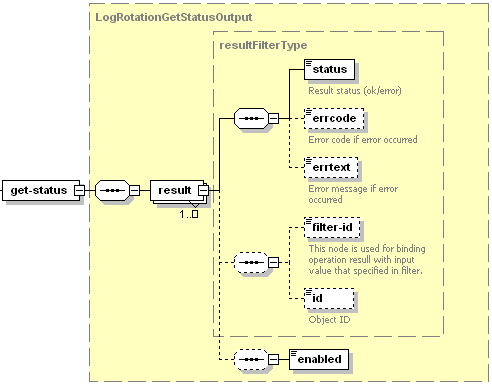Checking Status of Log Rotation Service
Use the get-status operation to retrieve status of Log Rotation service on sites.
Request Packet Structure
A request XML packet retrieving status of Log Rotation service includes the get-status operation node:
<packet>
<log-rotation>
<get-status>
...
</get-status>
</log-rotation>
</packet>
The get-status node is presented by type LogRotationDisableInput
(logrotation.xsd), and its graphical representation is as follows:

Note: The interactive schema navigator for all request packets is available here: http://plesk.github.io/api-schemas/1.6.9.1/agent_input.svg.
- The filter node is required. Specifies the filtering rule. For
more information, refer to the Available Filters
section. Data type: logRotationFilterType
(
logrotation.xsd) .
Remarks
You can use different filtering rules in a single packet. Add as many get-status operations as the number of different filtering rules.
<packet>
<log-rotation>
<get-status>
...
</get-status>
...
<get-status>
...
</get-status>
</log-rotation>
</packet>
Response Packet Structure
The get-status node of the output XML packet is presented by type
LogRotationGetStatusOutput (logrotation.xsd) and structured as
follows:

Note: The interactive schema navigator for all response packets is available here: http://plesk.github.io/api-schemas/1.6.9.1/agent_output.svg.
- The result node is required. It wraps the response retrieved
from the server. Data type: resultFilterType (
common.xsd). - The status node is required. It specifies the execution status of the get-status operation. Data type: string. Allowed values: ok | error.
- The errcode node is optional. It returns the error code if the get-status operation fails. Data type: unsignedInt.
- The errtext node is optional. It returns the error message if the get-status operation fails. Data type: string.
- The filter-id node is required. It returns a filtering rule parameter. For more information, refer to the Available Filters section. Data type: anySimple.
- The id node is optional. If the get-status operation succeeds it holds the ID of the site matched by the filtering rule. Data type: integer.
- The enabled node is optional. If the get-status operation succeeds, it holds status of the service on the site. Data type: integer.
Retrieving status of Log Rotation service on a single site
The following request packet retrieves status of Log Rotation service on site example.com:
<packet>
<log-rotation>
<get-status>
<filter>
<site-name>example.com</site-name>
</filter>
</get-status>
</log-rotation>
</packet>
Response:
<packet>
<log-rotation>
<get-status>
<result>
<status>ok</status>
<filter-id>example.com</filter-id>
<id>33</id>
</result>
</get-status>
</log-rotation>
</packet>
If the site was not found, the response from the server looks as follows:
<packet>
<log-rotation>
<get-status>
<result>
<status>error</status>
<errcode>1013</errcode>
<errtext>site does not exist</errtext>
<filter-id>example.com</filter-id>
</result>
</get-status>
</log-rotation>
</packet>
Retrieving status of Log Rotation service on multiple sites
The following request packet retrieves status of Log Rotation service on sites used by the customers with ID 5 and ID 8:
<packet>
<log-rotation>
<get-status>
<filter>
<owner-id>5</owner-id>
<owner-id>8</owner-id>
</filter>
</get-status>
</log-rotation>
</packet>
If the customer with ID 5 was not found on the server and the customer with ID 8 runs two domains (ID 17 and 29) the response from the server looks as follows:
<packet>
<log-rotation>
<get-status>
<result>
<status>error</status>
<errcode>1015</errcode>
<errtext>customer does not exist</errtext>
<filter-id>5</filter-id>
</result>
</get-status>
<get-status>
<result>
<status>ok</status>
<filter-id>8</filter-id>
<id>17</id>
</result>
</get-status>
<get-status>
<result>
<status>ok</status>
<filter-id>8</filter-id>
<id>29</id>
</result>
</get-status>
</log-rotation>
</packet>